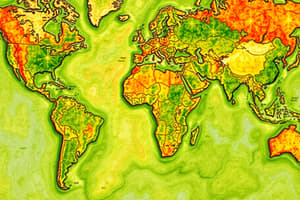Podcast
Questions and Answers
What primarily influences the distribution patterns of organisms in ecological biogeography?
What primarily influences the distribution patterns of organisms in ecological biogeography?
- Landforms and soil types
- Physical and biological environments (correct)
- Climate and land management
- Human population density
What characterizes primary succession in ecological systems?
What characterizes primary succession in ecological systems?
- Involves a pre-existing soil base
- Is accelerated by the presence of large animals
- Begins on a newly constructed deposit of sediment (correct)
- Occurs after a natural disaster
Which of the following best describes an ecological niche?
Which of the following best describes an ecological niche?
- The occupational role and environmental conditions an organism utilizes (correct)
- The process of competition among species
- A classification of organisms by their habitat type
- The physical space an organism occupies only
Secondary succession typically occurs in which type of area?
Secondary succession typically occurs in which type of area?
Which of the following is NOT a characteristic of biogeochemical cycles?
Which of the following is NOT a characteristic of biogeochemical cycles?
What happens during the pioneer stage of primary succession?
What happens during the pioneer stage of primary succession?
Which statement best describes the climax community in ecological succession?
Which statement best describes the climax community in ecological succession?
How do ecosystems react to different landforms?
How do ecosystems react to different landforms?
Flashcards are hidden until you start studying
Study Notes
Biogeography
- Focuses on distribution patterns of plants and animals across the Earth.
- Examines processes influencing distribution at various spatial and temporal scales.
Ecological Biogeography
- Investigates how organisms' distribution is affected by physical and biological environments.
- Factors include landforms, soil, and climate.
Historical Biogeography
- Explores how spatial distribution patterns develop over time due to evolution, migration, and extinction.
- Considers the historical context behind current biodiversity.
Biogeochemical Cycles
- Energy (E) flows from the sun, transforming through ecosystem components and can be lost to the atmosphere.
- Matter flows through ecosystems, cannot be lost to space; it is continuously formed, reformed, and recycled in cycles.
Physical and Biological Processes
- Distribution of organisms categorized as accessible or inaccessible based on location and environmental conditions.
- Matter exists in gas, liquid, or solid states within ecosystems.
Habitat
- Defined as subdivisions of the environment tailored to the needs of specific organisms or groups.
- Each habitat type fosters a distinct ecosystem, serving as the "address" for species.
Ecological Niche
- Refers to the functional role of an organism within an ecosystem along with its physical space, termed its "occupation".
Primary Succession
- Initiates on newly formed mineral deposits lacking true soil horizons.
- Pioneer stage includes few species adapted to harsh conditions.
- Pioneers enhance soil quality through root penetration and decay, aiding nutrient accumulation.
- As the community evolves, larger organisms replace pioneers, altering microclimates.
- Eventually leads to a climax community, characterized by stable species composition.
Secondary Succession
- Occurs in previously vegetated areas that have experienced disturbances (e.g., fire, flood, human activity).
- Example: old field succession on abandoned farmland, where soil base is already established.
- Succession dynamics influenced by the last land use, impacting the type of pioneer species that emerge.
Studying That Suits You
Use AI to generate personalized quizzes and flashcards to suit your learning preferences.




